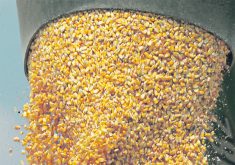Prairie wheat growers are heading into seeding with wheat prices looking good.
A $5 US per bushel price looks possible if the U.S. hard red winter wheat zone remains caught in a weather trap.
“It’s hot, dry and windy,” Oklahoma State University market analyst Kim Anderson said last week.
“We need 12 inches of rain just to break the drought.”
Anderson foresees a range of $4.50 to $5 US per bu. on the Kansas City Board of Trade’s July hard red winter wheat contract.
Read Also

Chinese, Indian tariffs take toll on pea prices
The disruption of pea exports from Canada’s largest customers will likely result in slow pea exports for the remainder of the crop year.
All signs point to a strong summer wheat market, Anderson said. He’s predicting a more than two-thirds chance that the Oklahoma June cash price will stay above $4 per bu. and a 20 percent chance that it will rise above $5.
The strong Kansas market also helped other wheat futures markets in Minneapolis and Chicago to rise.
But wheat prices are volatile. After hitting $4.69 per bu. April 11, the Kansas July contract dropped to $4.43 on April 17 on a forecast of rain in the winter wheat belt the weekend of April 22-23.
But if the rain is disappointing, prices could soar again.
And no matter what, some of the damage is permanent.
Crop insurance adjusters in southern Oklahoma and western Texas are writing off large areas of winter wheat. Southern Kansas, too, is seeing winter wheat crops erode by the day, as dry and windy conditions leave the crop without the moisture it needs to develop.
Much of the damage is permanent, and Anderson expects to see many fields in Oklahoma reseeded to cotton and in Texas to sorghum.
Anderson has downgraded his yield forecast weekly during the drought, and now expects a winter wheat crop of only 80 million bu. for Oklahoma this summer, compared to the five-year average of 140 million. He expects the Texas harvest to fall to about 50 million bu. from an average of 97 million bu.
In Kansas, the leading winter wheat producer, the crop is doing better. But its potential has begun to fall too. Last year’s crop was 380 million bu., and analysts now think Kansas’ crop could reach 360 million bu.
A crop similar to last year’s was predicted during the winter, but the drought has crawled up from the south and nibbled away at its potential.
“Every hot, dry, windy day, that’s going down,” said Anderson.
On April 17 the U.S. winter wheat crop was rated 32 percent poor to very poor, 29 percent fair and 39 percent good to excellent, down slightly from the previous week.















